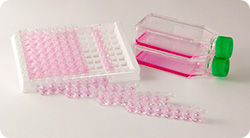| Cat. No. |
Product Name |
Activity |
| 14.3.3 Proteins |
| 2145 |
Difopein |
High affinity inhibitor of 14.3.3 proteins; induces apoptosis |
| 2144 |
R18 |
Inhibitor of 14.3.3 proteins; induces apoptosis |
| Bromodomains |
| 4650 |
I-BET 151 hydrochloride |
BET bromodomain inhibitor |
| 4499 |
(+)-JQ 1 |
Potent and selective BET bromodomain inhibitor |
| 4445 |
PFI 1 |
BET bromodomain inhibitor |
| DNA Methyltransferases |
| 2624 |
Decitabine |
DNA methyltransferase inhibitor |
| 4359 |
Lomeguatrib |
MGMT inhibitor |
| 3295 |
RG 108 |
Non-nucleoside DNA methyltransferase inhibitor |
| Histone Acetyltransferases |
| 3084 |
Anacardic acid |
Noncompetitive PCAF/p300 HAT inhibitor |
| 4200 |
C 646 |
Selective p300/CBP HAT inhibitor |
| Histone Deacetylases |
| 4593 |
GSK J1 |
Potent histone demethylase JMJD3/UTX inhibitor |
| 4594 |
GSK J4 |
Histone demethylase JMJD3/UTX inhibitor; cell permeable |
| 4077 |
MC 1568 |
Selectively inhibits HDAC class II (IIa) |
| 3747 |
NCH 51 |
Histone deacetylase inhibitor |
| 4403 |
Pyroxamide |
Histone deacetylase inhibitor |
| 3810 |
SBHA |
Histone deacetylase inhibitor |
| 2682 |
Sodium 4-Phenylbutyrate |
Histone deacetylase inhibitor |
| 4270 |
TC-H 106 |
Class I histone deacetylase inhibitor |
| 3852 |
Tranylcypromine hydrochloride |
Irreversible inhibitor of MAO-A, MAO-B and LSD1 |
| 1406 |
Trichostatin A |
Histone deacetylase inhibitor |
| 3402 |
Tubacin |
HDAC 6 inhibitor; inhibits α-tubulin deacetylation |
| Histone Methyltransferases |
| 3364 |
BIX 01294 |
G9a-like protein and G9a histone lysine methyltransferase inhibitor |
| 4504 |
Chaetocin |
Selective histone methyltransferase SUV39H1 inhibitor |
| 3861 |
UNC 0224 |
Potent G9a histone lysine methyltransferase inhibitor |
| 4343 |
UNC 0638 |
Selective G9a and GLP histone lysine methyltransferase inhibitor |
| 4342 |
UNC 0646 |
Potent and selective G9a/GLP inhibitor |
| Hypoxia Inducible Factors |
| 4408 |
DMOG |
Prolylhydroxylase inhibitor |
| 4451 |
IOX 2 |
Potent, selective HIF1α prolyl hydroxylase-2 (PHD2) inhibitor |
| JAK |
| 1571 |
Cucurbitacin I |
Selective inhibitor of STAT3/JAK2 signaling |
| 4338 |
NSC 33994 |
JAK2 inhibitor |
| MBT Domains |
| 4666 |
UNC 1215 |
Potent and selective L3MBTL3 domain inhibitor |
| 4516 |
UNC 926 hydrochloride |
Binds the MBT domain of L3MBTL1 polycomb group protein |
| Poly(ADP-ribose) Polymerase |
| 3735 |
BYK 49187 |
PARP-1 and PARP-2 inhibitor |
| 1401 |
NU 1025 |
Potent PARP inhibitor |
| 3255 |
PJ 34 hydrochloride |
Potent PARP inhibitor |
| 3748 |
XAV 939 |
Tankyrase inhibitor; inhibits Wnt signaling |
| Protein Serine/Threonine Phosphatases |
| 1136 |
Okadaic acid |
Protein phosphatase 1 and 2A inhibitor |
| 2613 |
NSC 87877 |
Potent inhibitor of shp2 and shp1 PTP |







 Multi-TLR Array™ provides a rapid and simple means to determine the TLR and NOD response of a given cell line or a biological sample. Multi-TLR Array™ is available as a 96-well plate with serial dilutions of 12 different lyophilized TLR and NOD agonists.
Multi-TLR Array™ provides a rapid and simple means to determine the TLR and NOD response of a given cell line or a biological sample. Multi-TLR Array™ is available as a 96-well plate with serial dilutions of 12 different lyophilized TLR and NOD agonists.































